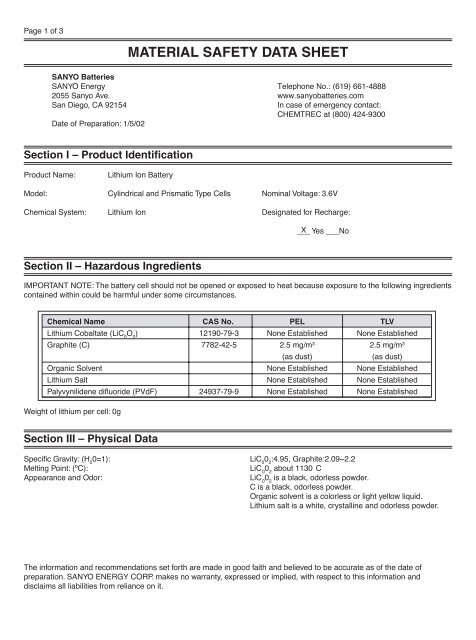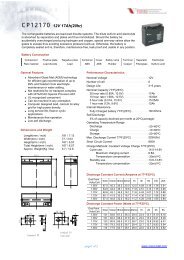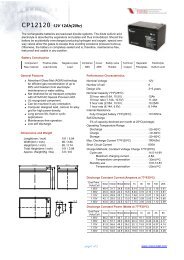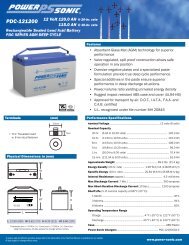MSDS (Sanyo Li-ion Battery) - Premier Batteries
MSDS (Sanyo Li-ion Battery) - Premier Batteries
MSDS (Sanyo Li-ion Battery) - Premier Batteries
You also want an ePaper? Increase the reach of your titles
YUMPU automatically turns print PDFs into web optimized ePapers that Google loves.
Page 1 of 3MATERIAL SAFETY DATA SHEETSANYO <strong>Batteries</strong>SANYO Energy2055 <strong>Sanyo</strong> Ave.San Diego, CA 92154Date of Preparat<strong>ion</strong>: 1/5/02Telephone No.: (619) 661-4888www.sanyobatteries.comIn case of emergency contact:CHEMTREC at (800) 424-9300Sect<strong>ion</strong> I – Product Identificat<strong>ion</strong>Product Name:<strong>Li</strong>thium Ion <strong>Battery</strong>Model: Cylindrical and Prismatic Type Cells Nominal Voltage: 3.6VChemical System: <strong>Li</strong>thium Ion Designated for Recharge:___ X Yes ___NoSect<strong>ion</strong> II – Hazardous IngredientsIMPORTANT NOTE: The battery cell should not be opened or exposed to heat because exposure to the following ingredientscontained within could be harmful under some circumstances.Chemical Name CAS No. PEL TLV<strong>Li</strong>thium Cobaltate (<strong>Li</strong>C 0O 2) 12190-79-3 None Established None EstablishedGraphite (C) 7782-42-5 2.5 mg/m 3 2.5 mg/m 3(as dust)(as dust)Organic Solvent None Established None Established<strong>Li</strong>thium Salt None Established None EstablishedPalyvynilidene difluoride (PVdF) 24937-79-9 None Established None EstablishedWeight of lithium per cell: 0gSect<strong>ion</strong> III – Physical DataSpecific Gravity: (H 20=1):<strong>Li</strong>C 00 2:4.95, Graphite:2.09~2.2Melting Point: (ºC): <strong>Li</strong>C 0 0 2about 1130CAppearance and Odor:<strong>Li</strong>C 0 0 2is a black, odorless powder.C is a black, odorless powder.Organic solvent is a colorless or light yellow liquid.<strong>Li</strong>thium salt is a white, crystalline and odorless powder.The informat<strong>ion</strong> and recommendat<strong>ion</strong>s set forth are made in good faith and believed to be accurate as of the date ofpreparat<strong>ion</strong>. SANYO ENERGY CORP. makes no warranty, expressed or implied, with respect to this informat<strong>ion</strong> anddisclaims all liabilities from reliance on it.
Page 2 of 3Sect<strong>ion</strong> IV — Fire and Explos<strong>ion</strong> Hazard DataExtinguishing Media:Flammable <strong>Li</strong>mits:Special Fire Fighting Procedure:WaterNot availableIn case of fire in an adjacent area, use water, CO2or dry chemicalextinguishers if cells are packed in their original containers since the fuel ofthe fire is basically paper products. For bulk quantities of unpackaged cellsuse LITH-X (Graphite Base). In this case, do not use water.Sect<strong>ion</strong> V - Reactivity DataStability:Condit<strong>ion</strong>s to Avoid:Hazardous Decomposit<strong>ion</strong> or By-products:Hazardous polymerizat<strong>ion</strong> will not occur.StableDo not heat, disassemble or recharge.N/ASect<strong>ion</strong> VI - Health Hazard DataRoutes of Entry: Inhalat<strong>ion</strong> YesSkinYesIngest<strong>ion</strong> YesHealth Hazards (Acute and Chronic):These chemicals are contained in a sealed can. Risk of exposure occurs only if the battery is mechanically orelectrically abused. The most likely risk is an acute exposure when the gas release vent works. Organic solvent hasslight toxicity and can irritate skin and eyes. <strong>Li</strong>thium salt is irritating to skin, eyes and mucous membranes and shouldbe avoided.Carcinogenicity:NTP: None IARC Monograph: None OSHA Regulated: NoneMedical Condit<strong>ion</strong>s Generally Aggravated by Exposure:An acute exposure will not generally aggravate any medical condit<strong>ion</strong>.Emergency and First Aid Procedures:In case of skin contact with contents of battery, flush immediately with water. For eye contact, flush with copiousamounts of water for 15 minutes. Do not inhale leaked material. If irritat<strong>ion</strong> persists, get medical help.Sect<strong>ion</strong> VII - Precaut<strong>ion</strong>s for Safe Handling and UseSteps to be Taken in Case Material is Released or Spilled:The preferred response is to leave the area and allow the batteries to cool and the vapors to dissipate.Avoid skin and eye contact or inhalat<strong>ion</strong> of vapors. Remove spilled liquid with absorbent and incinerate.Waste Disposal Method:Dispose in accordance with appropriate regulat<strong>ion</strong>s. Open cells should be treated as hazardous waste.The informat<strong>ion</strong> and recommendat<strong>ion</strong>s set forth are made in good faith and believed to be accurate as of the date ofpreparat<strong>ion</strong>. SANYO ENERGY CORP. makes no warranty, expressed or implied, with respect to this informat<strong>ion</strong> anddisclaims all liabilities from reliance on it.
Page 3 of 3Precaut<strong>ion</strong>s to be Taken in Handling and Storing:Avoid mechanical or electrical abuse.Other Precaut<strong>ion</strong>s:<strong>Batteries</strong> may explode or cause burns, if disassembled, crushed or exposed to fire or high temperatures. Do not shortor install with incorrect polarity.Sect<strong>ion</strong> VIII - Control MeasureRespiratory Protect<strong>ion</strong> (Specify Type):Ventilat<strong>ion</strong>:Protective Gloves:Eye Protect<strong>ion</strong>:Other Protective Clothing or Equipment:Not necessary under condit<strong>ion</strong>s of normal use.Not necessary under condit<strong>ion</strong>s of normal use.Not necessary under condit<strong>ion</strong>s of normal use.Not necessary under condit<strong>ion</strong>s of normal use.Not necessary under condit<strong>ion</strong>s of normal use.Sect<strong>ion</strong> IX - Recycling and DisposalSANYO encourages battery recycling. <strong>Li</strong>thium <strong>ion</strong> batteries are safe for disposal in the normal municipal waste stream sincethey are not defined by the federal government as hazardous waste. However, lithium <strong>ion</strong> batteries are recyclable. Forinformat<strong>ion</strong> contact Kinsbursky Brothers Inc. at (800)548-8797 or see their website at www.kinsbursky.com.DO NOT INCINERATE or subject battery cells to temperatures in excess of 212°F. Such treatment can cause cell rupture.Sect<strong>ion</strong> X - Transportat<strong>ion</strong>SANYO sealed <strong>Li</strong>thium <strong>ion</strong> batteries are considered to be "dry cell" batteries and are not subject to dangerous goodsregulat<strong>ion</strong> for the purpose of transportat<strong>ion</strong> by the U.S. Department of Transportat<strong>ion</strong> (DOT), the Internat<strong>ion</strong>al Civil Aviat<strong>ion</strong>Administrat<strong>ion</strong> (ICAO), the Internat<strong>ion</strong>al Air Transport Associat<strong>ion</strong> (IATA) or the Internat<strong>ion</strong>al Maritime Dangerous Goodsregulat<strong>ion</strong>s (IMDG). The only DOT requirement for shipping <strong>Li</strong>thium <strong>ion</strong> batteries is Special Provis<strong>ion</strong> 130 which states:"<strong>Batteries</strong>, dry are not subject to the requirements of this subchapter only when they are offered for transportat<strong>ion</strong> in amanner that prevents the dangerous evolut<strong>ion</strong> of heat (for example, by the effective insulat<strong>ion</strong> of exposed terminals)." IATArequires that batteries being transported by air must be protected from short-circuiting and protected from movement thatcould lead to short-circuiting.The informat<strong>ion</strong> and recommendat<strong>ion</strong>s set forth are made in good faith and believed to be accurate as of the date ofpreparat<strong>ion</strong>. SANYO ENERGY CORP. makes no warranty, expressed or implied, with respect to this informat<strong>ion</strong> anddisclaims all liabilities from reliance on it.








